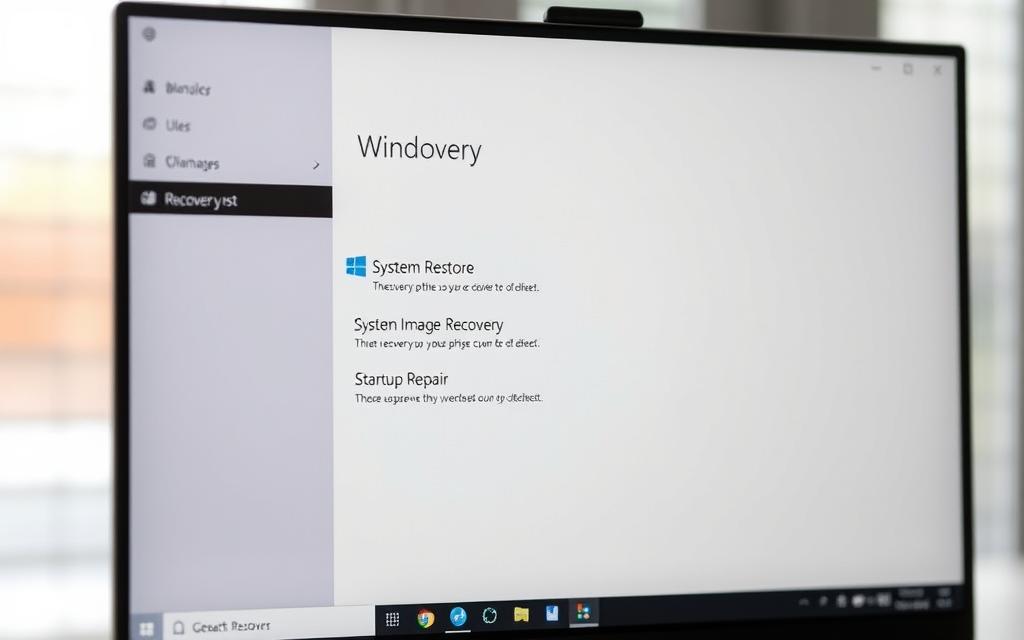When your machine crashes or shows stubborn errors, knowing how to fix it is key. You need a reliable way to get your device working smoothly again.
The system recovery process is like a safety net for your computer. It lets you go back to a time when everything was working well, fixing recent issues.
This guide helps both Windows and macOS users. You’ll learn expert methods to avoid losing data and costly repairs.
Learning these steps is a big plus for any computer user. It means you’re ready for any system problems that come your way.
We’ll show you the whole system recovery process step by step. This knowledge turns tough tech problems into easy fixes.
Understanding System Restore and Its Benefits
Before we get into how to restore your system, let’s understand what System Restore does. It’s a Windows feature that saves snapshots of your system at certain times. This acts as a digital safety net.
What is System Restore?
System Restore uses Windows restore points to save your system’s files, programs, and settings. Microsoft calls it a way to protect Windows’ system files and settings.
These restore points take pictures of your system’s registry, driver settings, and system files. But, they don’t touch your personal documents, photos, or emails. The feature automatically makes restore points before big system changes, like installing new software or updating Windows.
When to Use System Restore
System Restore is most useful when your computer has problems after changes. Use it when:
- Recently installed software causes system instability
- A driver update leads to hardware malfunctions
- System configuration changes result in unexpected behaviour
- Your computer experiences frequent crashes after system modifications
It’s great for undoing changes to system files and settings. But, it’s not for fixing malware or hardware issues.
Limitations and Considerations
System Restore is helpful but has its limits. It only protects system files, not personal files. Programs you’ve installed recently might be removed during a restore, but your documents are safe.
Two key things to remember: System Restore needs enough disk space to work. It can’t bring back files deleted before a restore point was made. And, it must be turned on before problems happen to be useful.
Knowing these points helps you understand what System Restore can and can’t do for your Windows system.
Prerequisites for Performing a System Restore
Before you start a system restore, you need to do three important things. These steps help keep your data safe and make sure the recovery goes well. Getting ready right is key to avoiding problems.

Backing Up Your Data
Creating a full backup is absolutely essential before you start. Windows has tools like ‘Backup and Restore’ or ‘File History’ to protect your files and settings. Regular backups keep your data safe, even if the restore process has problems.
Here are some tips for backing up:
- Use external storage or cloud services
- Set up automatic backups for ongoing protection
- Check your backups are good before you restore
Ensuring System Restore is Enabled
System Protection must be turned on for restore points to work. You can check this in System Properties in your Control Panel. It creates restore points before big changes, like new software or updates.
To set it up, you need to choose how much disk space for restore points. This choice affects how many old system states you can go back to. Getting this right means you have more options for fixing your system.
Identifying a Suitable Restore Point
Picking the right restore point is key to a successful recovery. System Protection makes points before big changes, but you can also make your own. This gives you more control over your system’s history.
When picking a restore point, think about:
- The date and time it was made
- The system changes that led to it
- If your computer was stable then
This careful choice is a vital part of any computer troubleshooting guide. It helps you get your system back to a good state without losing recent changes or settings.
How to System Restore Computer on Windows 10
Windows 10 has strong system protection features. It helps users fix computer problems. System Restore acts like a digital time machine. It lets you go back to a stable state without losing personal files.
Accessing System Restore
To start, type ‘Create a restore point’ in the search box. This opens the System Properties window. There, you’ll find the System Protection tab.
Click ‘System Restore’ to open the utility. You’ll see a welcome screen explaining the steps. Then, you can move on to the next step.
Selecting a Restore Point
Windows 10 lists restore points in order. Each point shows the date and time it was made. If you added a description, it will be there too.
When picking a restore point, think about these:
- Choose a point before your problems started
- Look at the description for big system changes
- Pick the most recent stable version
The system also shows which programmes and drivers will change. This helps you understand what will happen during the restore.
Confirming and Executing the Restore
After picking your restore point, check the confirmation screen. This step makes sure you know which drives will change.
Click ‘Finish’ to start System Restore. The system will ask if you’re sure you can’t stop it once it starts.
What to Expect During the Process
The restore usually takes 15-45 minutes. This depends on your computer’s specs and the data being processed. Your computer will restart on its own during this time.
You’ll see a progress bar showing how the restore is going. Don’t turn off your computer or unplug it during this important time.
After it’s done, Windows will load with your chosen settings. Check if your problem is fixed and if your personal files are safe.
| Stage | Duration | User Action Required | System Behaviour |
|---|---|---|---|
| Initialisation | 2-5 minutes | None | System prepares restoration environment |
| File Restoration | 10-30 minutes | None | System files revert to previous state |
| System Reboot | 5-10 minutes | None | Computer restarts with restored configuration |
| Completion | Instant | Verify restoration results | System loads with previous settings |
Remember, System Restore only changes system files and programmes. Your documents, photos, and personal data stay the same.
How to System Restore Computer on Windows 11
Windows 11 has a new way to recover your system. It keeps the core of System Restore but with a fresh look. The steps are similar to Windows 10 but with some changes.

Navigating to System Restore in Windows 11
To start System Restore, go to the Settings app. Microsoft has made it easier to find recovery options in Windows 11.
Here’s how to get to System Restore:
- Open Settings from the Start menu or using Windows key + I
- Select System from the left sidebar
- Scroll down and click on Recovery
- Find Advanced startup and click Restart now
- After restarting, choose Troubleshoot → Advanced options
- Select System Restore from the available recovery options
Choosing a Restore Point
Windows 11 shows restore points in a clean interface. It lists dates and descriptions. It also suggests the latest stable point before problems started.
To see more restore points, click “Choose a different restore point.” The interface lets you scan for programs that might be affected. This helps you know what changes will happen during the restore.
Completing the Restoration
After picking a restore point, you’ll get a confirmation. Windows 11 warns that you can’t stop the process once it starts.
The restore takes 15-45 minutes, depending on your system. Your computer will restart a few times. When it’s done, you’ll see a message saying your system is back to how it was.
Differences from Windows 10
Windows 11 makes recovery easier with some big changes. Now, you can find recovery options in the Settings app, not the Control Panel.
The interface is cleaner, thanks to Fluent Design. It has better spacing and clear instructions. Finding the right restore point is also easier now.
Another big change is how System Restore works with other tools. Windows 11 links System Restore with Reset this PC and other tools. This makes recovery more connected.
Using Time Machine for System Restore on macOS
While Windows users use System Restore, macOS has its own way to recover systems. Apple’s Time Machine is a powerful backup and restore tool. It saves your digital world at set times.
Overview of Time Machine
Time Machine is macOS’s built-in backup tool. It works quietly in the background. It makes:
- Hourly backups for the last 24 hours
- Daily backups for the last month
- Weekly backups for all months before
It keeps these backups until your storage is full. Then, it deletes the oldest ones. This way, you always have recent backups.
Initiating a Restore from Time Machine
To start the restore, plug in your Time Machine backup. Then, restart your Mac and hold Command + R to get into Recovery Mode.
In the macOS Utilities window, pick “Restore From Time Machine Backup.” The system will help you choose the right backup date. Pick the latest one before your problems started.
Time Machine doesn’t just save files—it saves your whole system state. This includes apps, system files, and settings.
The restore might take a few hours, depending on your data. Make sure your Mac is plugged in during this time.
Post-Restore Steps on Mac
After it’s done, your Mac will start up normally. Do these important checks:
- Open a few apps to check if they work
- Make sure important files are there and you can access them
- Test the internet and your devices
- Look over system preferences to see if they’re right
If you find missing files after the restore, you can get them back from your Time Machine backup. You won’t need to do a full system restore again.
Remember, keeping your Time Machine up to date is key. It’s your best defense for when you need it most.
Troubleshooting Common System Restore Issues
Even with careful preparation, system restoration methods can sometimes encounter unexpected challenges. Understanding how to address these problems ensures you can recover your system effectively when standard procedures don’t work as planned.

Restore Point Not Found
One of the most common issues users face is the inability to locate restore points. This typically occurs when System Protection isn’t properly configured or when disk space limitations prevent point creation.
Check your System Protection settings first. Ensure the feature is enabled for your system drive. Verify adequate disk space exists – Windows requires at least 300MB of free space, though 1GB is recommended for optimal performance.
If restore points remain unavailable, consider these solutions:
- Run System Restore from Safe Mode to bypass software conflicts
- Use administrative command prompt to check restore point availability
- Verify system files using SFC (System File Checker) scan
- Check event viewer logs for System Restore service errors
System Restore Fails or Stalls
When system restoration methods stall or fail completely, the process can leave your computer in an unstable state. Common causes include antivirus interference, disk errors, or insufficient system resources.
Begin troubleshooting by attempting the restore in Safe Mode. This minimal environment eliminates many software conflicts that can interrupt the process. Disable your antivirus temporarily before initiating the restore, as security software sometimes blocks system changes.
For persistent failures, consider these advanced options:
- Run CHKDSK to check for disk errors before restoring
- Use Windows Recovery Environment (WinRE) for more control
- Check system logs for specific error codes indicating the failure cause
- Ensure all drivers are updated before attempting restoration
Recovering from an Unsuccessful Restore
When standard system restoration methods prove unsuccessful, alternative recovery options become necessary. Windows provides several built-in tools for these situations, while manufacturers offer additional solutions.
The ‘Reset This PC’ feature represents your next logical step. This option reinstalls Windows while preserving your personal files, applications, and settings. It effectively addresses system corruption that System Restore cannot fix.
For more severe cases, consider these advanced recovery strategies:
| Recovery Method | Best For | Considerations |
|---|---|---|
| Windows Recovery Environment | System startup failures | Requires installation media or recovery drive |
| System Image Recovery | Complete system restoration | Needs previously created system image backup |
| Manufacturer Recovery Tools | Hardware-specific issues | Dell Backup and Recovery, HP Cloud Recovery, etc. |
| Clean Windows Installation | Severe system corruption | Will erase all programs and settings |
Manufacturer-specific tools like Dell’s Backup and Recovery system provide tailored solutions for hardware-related issues. These utilities often include diagnostic tools that can identify underlying problems affecting restoration attempts.
Always ensure you have recent backups before attempting advanced recovery options. While these system restoration methods can resolve most issues, having backup protection ensures you never lose important data during the recovery process.
Conclusion
Learning how to restore systems is key to keeping your computer safe. It helps prevent crashes and data loss. Knowing how to use Windows System Restore and macOS Time Machine is very helpful.
Regular backups and automated restore points are vital for computer care. Tools like Acronis True Image add extra protection. They help keep your system and data safe.
Knowing how to restore your system gives you peace of mind. It turns fixing computer problems into a proactive step. This skill keeps your computer running smoothly for a long time.















